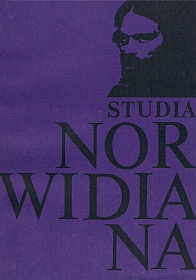The Functions of the Hyphen in Cyprian Norwid’s Poetry
Abstract
The hyphen may have two different textual functions: linking and division. In its function as a link the hyphen serves to combine separate words into quasi-idiomatic semantic units, such as Norwid’s Duch-Stworzenia, wiosna-życia, czasów-krok, przesytu-Niedziela, historii-piqtek, litera-prawa. Norwid uses the hyphen to link groups o f two or more words intended to be interpreted, in the given context, as a semantic whole. The modifying element then contributes information which the poet considers essential-and without which he would find it impossible to give an accurate name to the head of the construction. In constructions of a noun modified by an adjective the hyphen neutralizes the semantic function of word order. Irrespective of the pre- or postnominal position o f the adjective, the modifier brings out the contextually important qualities o f the head. Combinations with the hyphen as a linking device may be something transitional between a word and a sentence. They may be interpreted ambiguously as either lexemes or syntactic constructions. For instance, klamstwo-wiedzy may be understood as (1) the name o f spurious knowledge or (2) a nominalization of the sentence “wiedza kłamie” (knowledge lies). The hyphen facilitates abbreviation and semantic condensation, and opens a phrase to a variety of interpretations.
In its dividing function the hyphen is a kind of typographical metalinguistic comment. It singles out either parts of a word which Norwid regards as significant and semantically autonomous (przy-czyny , prze-życie, roz-um) or such grammatical elements as endings, inflectional bases and particles (ja-m, odrzuca-ć, jest-że, poznał-ci-żebym, ktoś-ty).
Norwid’s hyphenated spelling is to some extent in compliance with the spelling conventions o f the time. We can speak of innovations only in the case of the linking hyphen in the group of common nouns (both metaphorical and non-metaphorical combinations) and proper names o f native origin (cf. diagram A I). Etymologies employing the hyphen, analysis of words into smaller meaningful elements, compounding with wszech- and poł-, all these are the legacy of common nineteenth century philosophical reflection on language.
On the phonetic plane, the linking hyphen brings words together to form rhythmic units, enhances the expressiveness o f word combinations and makes for the rhetorical quality of a text. It is an element not to be overlooked in the oral delivery of Norwid’s poems.
Copyright (c) 1987-1988 Studia Norwidiana

This work is licensed under a Creative Commons Attribution-NonCommercial-NoDerivatives 4.0 International License.





